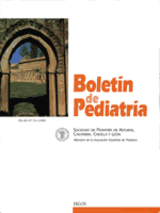Hemangiomas y malformaciones vasculares. ¿Qué se puede hacer?
E.M. de Diego García , I. Fernández Jiménez , M.S. Trugeda Carrera , F. Sandoval González
Bol. Pediatr. 2001; 41 (176): 137 - 143
La gran mayoría de las anomalías vasculares que se presentan en la infancia pueden diferenciarse mediante un examen físico y una historia clínica exhaustivas. En ocasiones, se deberá recurrir a la ultrasonografía Doppler o a la resonancia nuclear magnética para diagnosticarlas, principalmente en lesiones profundas de aspecto no definido. La clasificación de las anomalías vasculares se establece en base a criterios biológicos, como hemangiomas y malformaciones vasculares. Esta clasificación incluye datos físicos, conducta clínica y cinética celular. Establecer un diagnóstico diferencial entre ambos tipos de anomalías, permitirá una mejor comprensión y, por tanto, una actitud frente a ellas acorde con su evolución clínica. Los hemangiomas son las neoplasias benignas más frecuentes en el lactante; manifestándose en las primeras semanas de vida con un crecimiento rápido como dato característico, que se prolonga de forma atenuada hasta el año de edad. Corresponde a la fase proliferativa, posteriormente se continúa con una fase de involución que alcanza hasta los 7-10 años. Las malformaciones vasculares (VM) no son neoplasias, son anomalías de los vasos debido a errores en la morfogénesis vascular. Se derivan de conductos capilares, arteriales, venosos o linfáticos embrionarios, o por combinación de los anteriores. Su clínica y tratamiento variarán en función de su hemodinámica, tamaño y localización anatómica. Las malformaciones vasculares en el momento del nacimiento ya están presentes por definición, no presentan proliferación celular y no tienen potencial involutivo. Abstract Most of the vascular abnormalities that occur in childhood can be differentiated by a physical examination and exhaustive clinical history. Sometimes, it is necessary to use the Doppler ultrasonograph or Magnetic Nuclear Resonance to diagnose them, principally in profound lesions with undefined appearance. Classification of vascular abnormalities is established based on biological criteria, such as hemangiomas and vascular malformations. This classification includes physical, clinical behavior and cellular kinetics data. Establishing a differential diagnosis between both types of abnormalities will make it possible to obtain better understanding and thus attitude related to them in accordance with their clinical evolution. Hemangiomas are the most frequent benign neoplasms in infants and are seen in the first weeks of life with rapid growth which continues up to one year of age in a lesser form as a characteristic piece of data. This corresponds to the proliferative phase, which then continues with an involution phase up to 7-10 years of age. Vascular malformations (VM) are not neoplasms. They are abnormalities of the vessels due to errors in vascular morphogenesis. They are derived from capillary, arterial, venous or embryonic lymphatic behaviors or due to combinations of these. Their symptoms and signs and treatment vary according to their hemodynamics, size and anatomic site. Vascular malformations at birth are already present by definition and do not present cellular proliferation and have no involutive potential.
\N
\N
Artículo completo (PDF) (41 kb.)
- Cirugía
